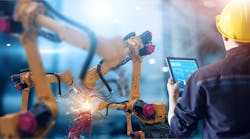“Safety is not a gadget but a state of mind,” said the safety expert Eleanor Everet. Industrial robots are used to separate workers from dangerous tasks—but what do we do when robots are the problem? Here, Claudia Jarret, US country manager at EU Automation, explains why a culture shift is needed if manufacturers are to guarantee safety in their robots.
Robots have long been used to separate human workers from dull, dangerous or dirty tasks in factories and warehouses—that’s nothing new. Considering that 888,220 instances of non-fatal injury or illness caused private workers in the United States to miss at least one day of work in 2019, according to the Bureau of Labor Statistics, there’s always a requirement for better workplace safety.
But, what about instances where robots are the unsafe problem? Forbes highlights the widely-reported 2016 incident where a semi-autonomous driving Tesla car collided with a tractor-trailer in Florida, killing its driver. But it also highlights lesser-known examples, such as when an industrial robot killed a German factory employee in 2015 and another killed a Michigan worker in 2017.
Concerns of robots injuring their human colleagues will become a more pressing issue as the continuing COVID-19 pandemic accelerates the adoption of automation in the workplace, to support social distancing and fewer workers on the shop floor. In The Future of Jobs Report, more than 80% of business executives said they are accelerating plans to digitize work processes and deploy new technologies. 50% of employers are expecting to accelerate the automation of some roles in their companies.
Who’s Responsible?
Robots can’t be blamed for the accidents they cause, of course. Accidents must be attributed to the people behind the machines — to human error, miscalculations or programming errors. That’s why initiatives are needed to prepare the workforce for automation and to operate robots both effectively and safely.
Reskilling employees will be crucial to embracing automation. In fact, the McKinsey Global Institute report, Jobs lost, jobs gained: Workforce transitions in a time of automation, estimates that as many as 375 million workers—or roughly 14 percent of the global workforce—may need to reskill in digitization, automation, and artificial intelligence by 2030. According to some, bringing workers into the automation fold will be the biggest challenge since the large-scale shift from agricultural work to manufacturing in North America and Europe, during the early 20th century.
Having the Skills
It’s true that making sure workers have the right skills to deal with robots, and automation in general, won’t be easy, and different companies are approaching this in different ways. Upskilling workers seems to be the most popular course—one example is Amazon’s ‘Upskilling 2025’ initiative, an announcement that it plans to spend $700 million dollars to retrain a third of its workforce with skills for automation.
Other companies have further to go. 52% of industrial workers interviewed in the Digital Factories 2020: Shaping the future of manufacturing report by PricewaterhouseCoopers (PwC) believed their company lacks a true digital culture.
“Culture” is the keyword here. In order for any upskilling program to be truly effective, employers must give workers a seat at the table. Automation will create, as well as reduce, opportunities for employees of varying skill levels. It will require higher levels of skill from some workers while reducing the levels of skill needed from others.
Therefore, companies must invest in and train their staff to get the most from the latest human-machine interfaces (HMIs) for robots, along with SCADA and enterprise resource planning (ERP) systems—wherever they fall on the skills ladder.
A better digital culture means winning employees’ confidence. PwC’s Digital Factories 2020 report puts it best: “It is absolutely vital to include employees at all stages of developing and introducing new technologies.” The report suggests that workers be involved in evaluating possible robotic technologies; testing and rolling out the technologies in pilot projects, and finally rolling them out in production. The buy-in of employees can be earned through these steps.
Safe in the Knowledge
Which brings us back to safety. Getting workers involved, and trained, with technologies at the earliest stages can double-up with effective risk assessment and understanding potential safety hazards. Safety and training can go hand-in-hand by ensuring each worker is trained to follow the safety protocol and avoid risks of on-site accidents and injuries—whatever their skill level.
Training in the safe use of robots also goes beyond the technologies’ installation. As the national safety guidelines for the manufacturing industry are always changing, periodic training must be delivered to workers to ensure they can operate the machinery safely.
Safety of robots must also be guaranteed over the long-term. One way to achieve this is being explored by MIT in collaboration with the automobile manufacturer BMW, by using simulations to develop algorithms that help robots predict and respond to humans in close proximity, such as on a car production line.
And, as well as the humans, let’s not forget the robots themselves. Effective maintenance is absolutely integral to the safe operation of robots. This is where the support of an automation parts supplier like EU Automation is vital for ensuring the right robot parts are sourced and delivered globally, on-time—even during the ongoing COVID-19 pandemic.
Not only can robots have a positive impact on the workplace, they can also separate their human work colleagues from injurious tasks—but manufacturers must reskill their workforces accordingly. As Everet said, “Safety is not a gadget, but a state of mind.”











